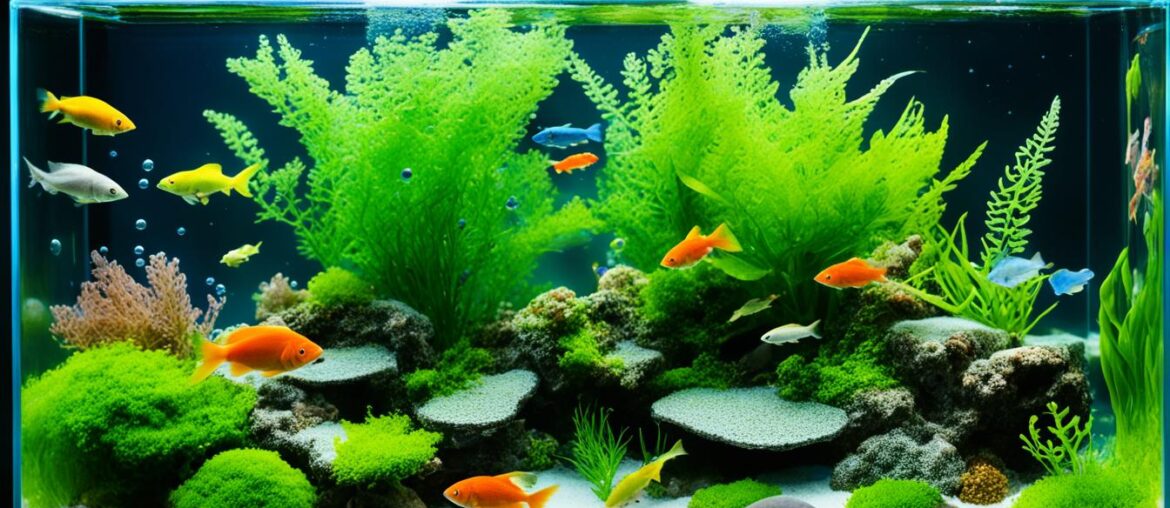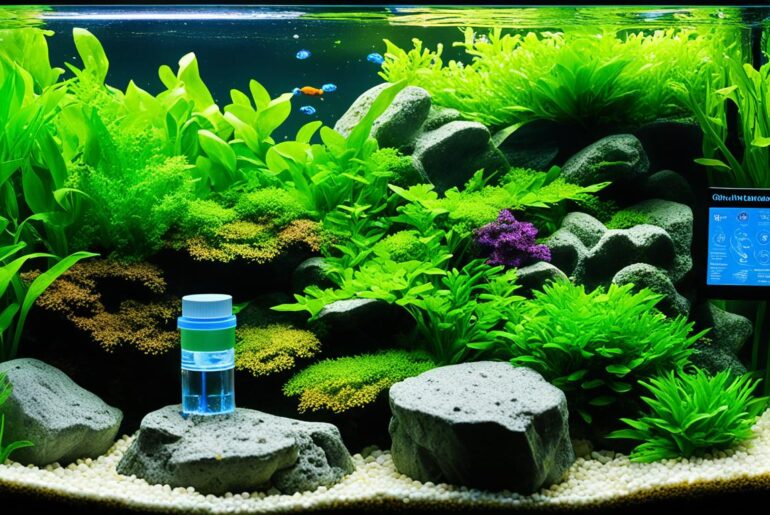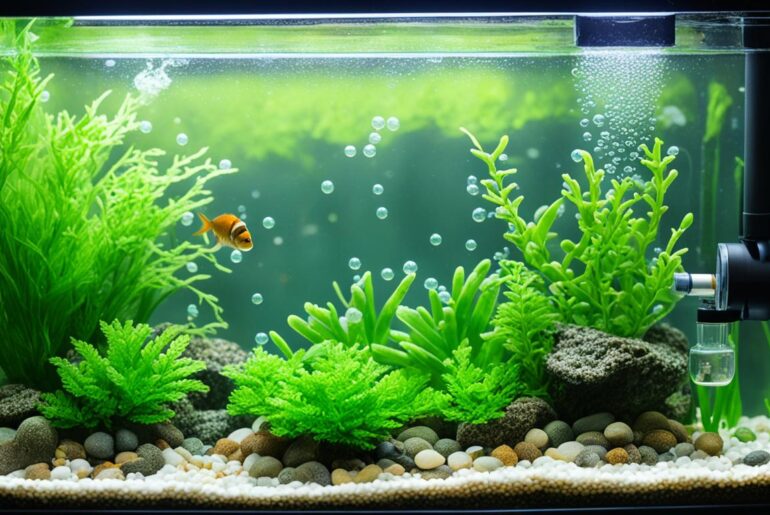As a child, I was fascinated by the vibrant colors and graceful movements of tropical fish. I longed to create my own underwater oasis, a place where these stunning creatures could thrive and enchant me with their beauty. However, little did I know that the secret to a successful aquarium wasn’t just a matter of filling it with water and adding fish. It was a delicate process called aquarium cycling.
When I first embarked on this journey, I was overwhelmed by the technicalities and complexities of it all. But as I delved deeper into the world of aquariums, I discovered the wonders of beneficial bacteria and the vital role they play in maintaining a healthy underwater ecosystem.
The process of aquarium cycling involves introducing these beneficial bacteria to regulate the nitrogen cycle, ensuring that the harmful effects of ammonia buildup are kept at bay. It took time, patience, and careful monitoring of water parameters, but the reward was well worth it.
Creating a biologically safe environment for my fish not only ensured their well-being but also brought me a profound sense of joy and satisfaction. Watching them flourish in their new home, with vibrant colors and energetic movements, was a sight I will never forget.
Key Takeaways:
- Aquarium cycling is a crucial step in setting up a healthy underwater ecosystem for your fish.
- Beneficial bacteria play a vital role in converting harmful ammonia into nitrite and then nitrate.
- Cycling an aquarium takes time, patience, and regular monitoring of water parameters.
- Creating a biologically safe environment for your fish brings immense joy and satisfaction.
- By mastering the art of aquarium cycling, you can create a thriving underwater oasis for your fish to thrive in.
What is Aquarium Cycling?
Aquarium cycling is a crucial process in creating a biologically safe environment for fish in a new tank, ensuring their long-term health and well-being. It involves introducing nitrifying bacteria into the aquarium to regulate the nitrogen cycle. This cycle is essential for maintaining a healthy fish tank by converting harmful ammonia, produced from fish waste breakdown, into nitrite and then nitrate.
Without proper cycling, ammonia levels can rise and harm the fish, leading to what is known as “New Tank Syndrome”. To complete the nitrogen cycle, nitrifying bacteria must spread across the aquarium’s biological filters to handle the ammonia produced by the fish.
Cycling an aquarium is time-consuming, but it is a necessary step for the overall success and sustainability of the aquatic environment. By establishing a balanced nitrogen cycle, aquarium cycling creates a healthier and more stable habitat for your fish.
In the image above, you can visually see the various stages of the nitrogen cycle.
Why is Aquarium Cycling Important?
Aquarium cycling plays a vital role in ensuring the health and well-being of your fish and the overall stability of your aquarium. Without proper cycling, your fish can be exposed to high levels of toxins, particularly ammonia, which can have detrimental effects on their health. This is commonly known as “New Tank Syndrome”. By cycling your aquarium, you create a biologically prepared environment that can effectively handle the waste load produced by your fish, preventing the buildup of harmful toxins and promoting fish health.
Cycling your aquarium is essential for the following reasons:
- Fish Health: Proper aquarium cycling helps maintain optimal water quality, which is crucial for the overall health and longevity of your fish. By establishing a stable nitrogen cycle, the conversion of ammonia to nitrite and then to nitrate is regulated, ensuring the fish are not exposed to toxic levels of ammonia. This reduces stress and potential health issues caused by ammonia exposure.
- New Tank Syndrome: Cycling your aquarium helps prevent “New Tank Syndrome,” which occurs when harmful toxins, such as ammonia and nitrite, build up in a new aquarium. This can be detrimental to the fish, leading to health problems and even death. By cycling your tank properly, you create an environment where beneficial nitrifying bacteria can establish and effectively handle the waste produced by the fish, preventing the onset of “New Tank Syndrome.”
“Proper aquarium cycling prevents the harmful effects of toxins, promotes fish health, and prevents ‘New Tank Syndrome.'”
Cycling an aquarium is especially important for less hardy fish species that are more susceptible to ammonia exposure. By establishing a stable and well-functioning nitrogen cycle, you create a healthier and more suitable environment for these delicate fish, reducing the risk of ammonia-related health issues. Additionally, a properly cycled aquarium provides a foundation for maintaining stable water parameters, which is crucial for the long-term well-being of your fish.

Regular monitoring of water parameters, such as ammonia, nitrite, and nitrate levels, is essential to ensure the continued success of the cycling process and the health of your fish. It is recommended to use a reliable aquarium test kit to regularly test and maintain proper water quality. By cycling your aquarium and monitoring water parameters, you create a safe and healthy environment that supports the thriving ecosystem of your fish.
The Importance of Aquarium Cycling
| Benefits | Explanation |
|---|---|
| Promotes Fish Health | Proper aquarium cycling helps maintain optimal water quality, reducing the risk of ammonia exposure and related health issues for the fish. |
| Prevents New Tank Syndrome | Cycling an aquarium ensures the establishment of beneficial nitrifying bacteria that can effectively process fish waste, preventing the buildup of harmful toxins. |
| Protects Less Hardy Fish Species | Less hardy fish species are more prone to ammonia exposure. By cycling the aquarium, you create a healthier environment that reduces the risk of ammonia-related health problems. |
How Long Does Aquarium Cycling Take?
Aquarium cycling is a crucial process that establishes a healthy environment for your fish. The duration of the cycling process can vary depending on several factors, including tank size, water temperature, and pH levels. On average, aquarium cycling takes approximately four to eight weeks to complete.
To expedite the cycling process, it is important to maintain proper water parameters. The pH of the water should fall within the range of 7.0 to 7.8. Additionally, the water temperature should ideally range from 83°F to 87°F. Monitoring these parameters regularly will help ensure a successful cycling process.
During the cycling process, it is essential to regularly test the levels of ammonia, nitrite, and nitrate in the tank. Ideally, these levels should be monitored every one to two days. In a properly cycling tank, you will notice a drop in ammonia levels, a significant spike in nitrites, and the presence of nitrates. Once the ammonia and nitrite levels reach zero and nitrates are being produced, the cycling process is considered complete.
Cycling an aquarium requires patience and diligence, but it is crucial for the long-term health of your fish. By closely monitoring water parameters and ensuring the appropriate duration for aquarium cycling, you can establish a thriving underwater ecosystem for your aquatic pets.
| Factors | Duration |
|---|---|
| Tank Size | Varies |
| Water Temperature | 4 to 8 weeks |
| pH Levels | 7.0 to 7.8 |
How to Cycle an Aquarium without Fish
When it comes to cycling your aquarium, it is highly recommended to do it without fish, especially if you’re a beginner. Fishless cycling offers a more humane and controlled process that ensures the well-being of your future fish. To cycle an aquarium without fish, follow these steps:
-
Set up the tank’s components: Start by properly installing and ensuring the functionality of filters, pumps, substrate, and other tank components. This allows nitrifying bacteria to accumulate on the surfaces of the aquarium, particularly the filters and substrate.
-
Check the water’s pH: Maintaining the pH level between 7.0 and 7.8 creates an ideal environment for the nitrogen cycle.
-
Add ammonia to the tank: Use fish food to raise ammonia levels in the aquarium. This provides the necessary food source for nitrifying bacteria.
-
Check ammonia levels: Regularly monitor ammonia levels using a test kit and aim for an ideal concentration of around 3 parts per million (ppm).
-
Check nitrite levels: After maintaining appropriate ammonia levels for about a week, nitrite levels should become detectable.
-
Check nitrate levels: As nitrite levels begin to decline, you’ll notice the presence of nitrates in your water. This indicates progress in the cycling process.
-
Introduce fish into the tank: Once the tank has completed the cycling process and nitrates are being produced, you can slowly and responsibly introduce fish into the aquarium. Remember to continue monitoring and regulating water parameters to ensure the health of your fish.
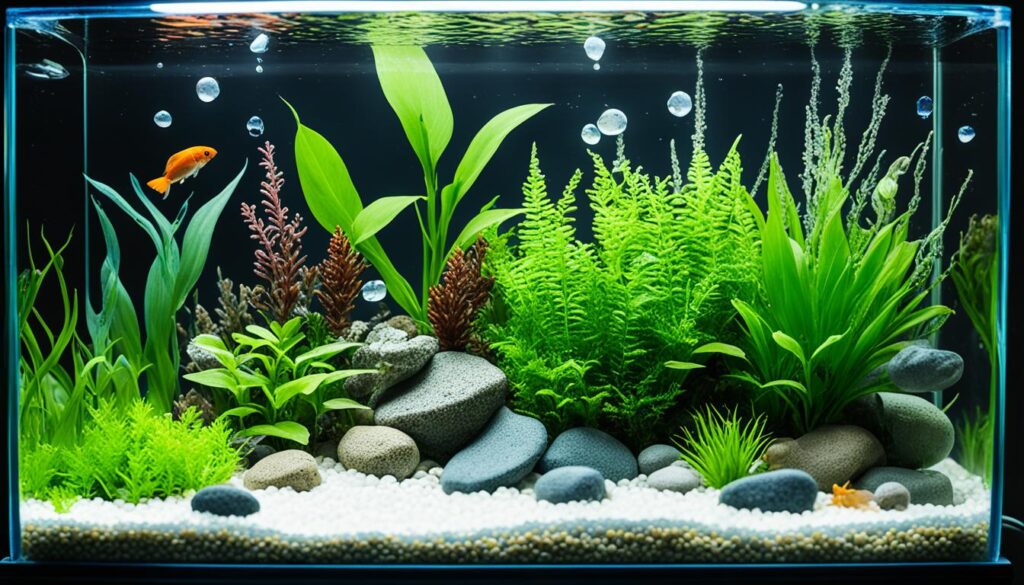
How to Cycle an Aquarium with Fish
Fish-in cycling is an alternative method to cycle an aquarium that involves adding fish to the tank during the cycling process. While this approach can be effective, it requires caution and close monitoring to ensure the well-being of the fish. Follow these steps for fish-in cycling:
- Set up the tank’s components: Install all necessary components, such as filters, pumps, and temperature regulators, to create a suitable environment for the fish.
- Add a few hardy fish to the tank: Choose resilient fish species that can tolerate ammonia and other contaminants during the cycling process. This helps to minimize stress and potential harm to the fish.
- Feed your fish lightly: Start with small amounts of food and gradually increase the feeding over four to six weeks. This allows time for beneficial bacteria in the tank to consume the fish waste, preventing ammonia buildup.
- Measure water quality: Regularly use ammonia test strips and multi-test strips to monitor water quality. Perform partial water changes when ammonia or nitrite levels exceed acceptable levels. This helps to maintain a healthy and stable environment for the fish.
- Complete the cycle: The cycling process is considered complete when ammonia and nitrite levels stay consistently at 0 ppm and nitrate levels are above 0 ppm for an extended period. At this point, the tank can handle the fish’s waste load. Slowly introduce more fish into the aquarium, ensuring that the bacterial growth keeps up with the increased waste.
Fish-in cycling requires careful observation and regular water changes to maintain a healthy environment for the fish. Monitoring water parameters and ensuring proper feeding practices are essential for the success of this method. Remember to prioritize the well-being of the fish throughout the cycling process.

Cycling an Aquarium with Plants
Cycling an aquarium with plants offers numerous benefits and creates a beautiful and natural ecosystem within your tank. Plants play a vital role in the cycling process by effectively consuming nitrogen waste, often more efficiently than bacteria. Not only do they enhance the visual appeal of your aquarium, but they also significantly improve water quality for your fish.
To successfully cycle a planted tank, follow these steps:
- Add live aquarium plants: Introduce live plants into your tank immediately during the cycling process. Ensure they receive adequate lighting, substrate, and fertilizers to promote healthy growth.
- Monitor plant growth: As your plants grow and establish themselves, they consume ammonia and nitrates, converting them into new leaves and roots. This active consumption of nitrogen waste contributes to the overall cycling process.
- Gradually introduce fish: Once your plants exhibit new growth and the tank has completed cycling, you can gradually add a few fish. Remember to monitor ammonia and nitrite levels, ensuring they remain at 0 parts per million (ppm), while nitrate levels stay below 40 ppm.
Cycling your tank with plants not only creates a visually appealing underwater landscape but also improves the overall water quality for the well-being of your fish.
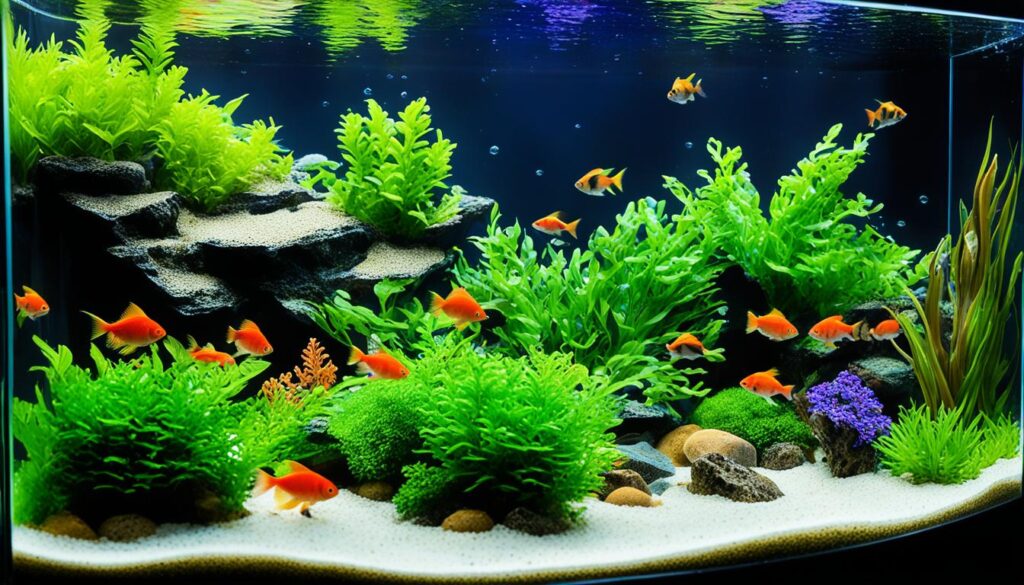
Troubleshooting Aquarium Cycling
If, after six to eight weeks of cycling, you find that your aquarium still has high levels of ammonia and nitrite, it’s time to troubleshoot the issue. Here are some possible solutions to address the problem:
- Treating the water: Ensure that the tap water you use to fill the tank is treated to remove chlorine and chloramine. These chemicals can disrupt the cycling process and contribute to high ammonia and nitrite levels.
- Regular water changes: Perform regular water changes to remove excess waste and prevent the buildup of toxins. This helps to dilute the levels of ammonia and nitrite in the tank.
- Adjust feeding: If you notice that excess food is decaying and causing high ammonia levels, adjust your feeding routine. Feed your fish smaller amounts and remove any uneaten food promptly to reduce the source of waste.
- Avoid using ammonia removers: While it may be tempting to use chemicals that claim to remove ammonia from the water, these products can harm the beneficial bacteria responsible for cycling the tank. It’s best to rely on natural methods rather than artificial shortcuts.
- Consider the source of waste: Evaluate the tank to identify any potential sources of waste, such as dead fish, extra food, or decaying plant matter. Remove any waste promptly to prevent it from contributing to high ammonia and nitrite levels.
Troubleshooting cycling issues will help ensure a successful and healthy cycling process for your aquarium, creating a safe and thriving environment for your fish.
| Possible Solutions | Benefits |
|---|---|
| Treating the water | Prevents disruption to the cycling process |
| Regular water changes | Removes excess waste and toxins |
| Adjust feeding | Reduces the source of waste |
| Avoid using ammonia removers | Preserves the beneficial bacteria |
| Consider the source of waste | Eliminates potential contributors to high ammonia and nitrite levels |
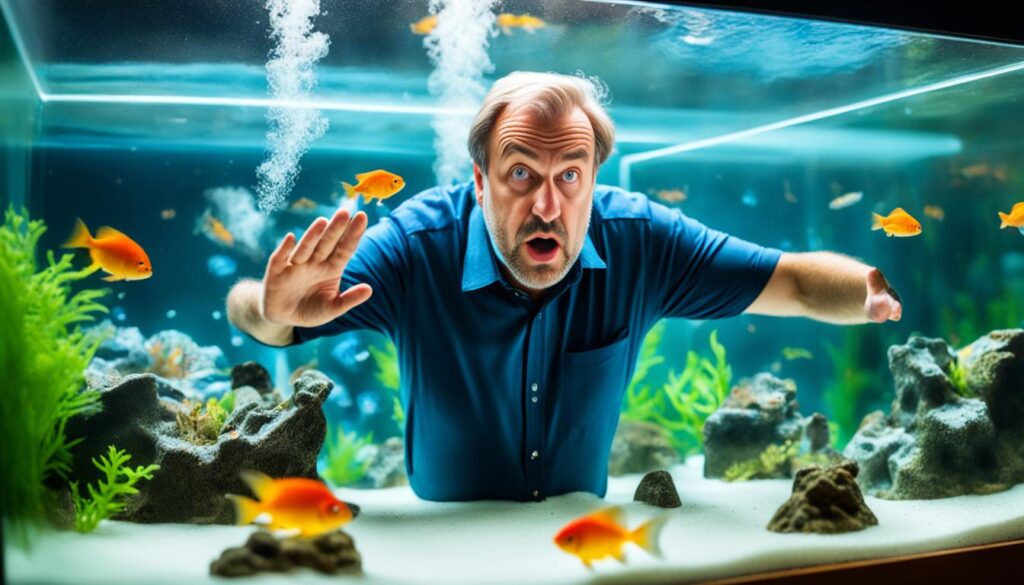
Conclusion
Cycling your first aquarium is an essential step in creating a successful and thriving underwater ecosystem for your fish. It involves the introduction of nitrifying bacteria, which regulate the nitrogen cycle and help maintain a safe environment for your fish. By following the essential tips for aquarium cycling, you can ensure that your tank is biologically prepared and free from harmful toxins.
Whether you choose to cycle your aquarium with or without fish, attention to detail and regular monitoring of water parameters are crucial. By maintaining proper ammonia, nitrite, and nitrate levels, you can achieve a healthy balance and prevent any adverse effects on your fish’s health.
Remember, successful aquarium cycling takes time and patience. It generally takes four to eight weeks to complete the process, but the results are well worth the wait. Once your aquarium has successfully cycled, you can enjoy a vibrant and thriving underwater ecosystem that provides a safe and healthy habitat for your fish to thrive in.
FAQ
What is aquarium cycling?
Aquarium cycling is the process of creating a biologically safe environment for fish in a new tank. It involves introducing nitrifying bacteria into the aquarium to regulate the nitrogen cycle. Nitrifying bacteria convert ammonia, produced by fish waste breakdown, into nitrite and then nitrate. This conversion is essential for maintaining a healthy environment for the fish.
Why is aquarium cycling important?
Aquarium cycling is important to ensure the tank is biologically prepared for fish and to prevent “New Tank Syndrome”. Without proper cycling, fish can be exposed to high levels of toxins, particularly ammonia, which can harm their health. Cycling the tank allows nitrifying bacteria to establish themselves and handle the ammonia produced by the fish, creating a healthier environment.
How long does aquarium cycling take?
The duration of aquarium cycling can vary, but it generally takes four to eight weeks to complete. Factors such as tank size, water temperature, and pH levels can affect the duration of the cycling process. Regular monitoring of water parameters is necessary to ensure successful cycling.
How to cycle an aquarium without fish?
To cycle an aquarium without fish, follow these steps: 1. Set up the tank’s components, 2. Check the water’s pH, 3. Add ammonia to the tank, 4. Check ammonia levels, 5. Check nitrite levels, 6. Check nitrate levels, 7. Introduce fish into the tank once the cycling is complete. Fishless cycling is recommended, especially for beginners.
How to cycle an aquarium with fish?
To cycle an aquarium with fish, follow these steps: 1. Set up the tank’s components, 2. Add a few hardy fish to the tank, 3. Feed your fish lightly, 4. Measure water quality, 5. Complete the cycle. Fish-in cycling requires careful observation and regular water changes to maintain a healthy environment for the fish.
How to cycle an aquarium with plants?
To cycle a tank with plants, follow these steps: 1. Add live aquarium plants, 2. Monitor plant growth, 3. Gradually introduce fish. Cycling a tank with plants creates a natural ecosystem and improves water quality for the fish.
How to troubleshoot aquarium cycling issues?
If ammonia and nitrite levels remain high after six to eight weeks of cycling, possible solutions include treating the water, performing regular water changes, adjusting feeding, avoiding ammonia removers, and evaluating the source of waste in the tank.
Conclusion
Cycling your first aquarium is a necessary step in creating a healthy underwater ecosystem for your fish. By following the essential tips for cycling, you can establish a thriving and safe environment for your fish to enjoy.
